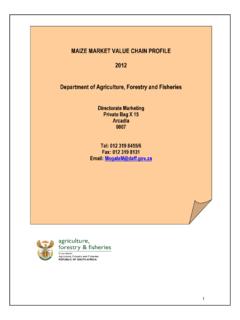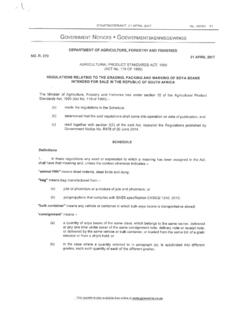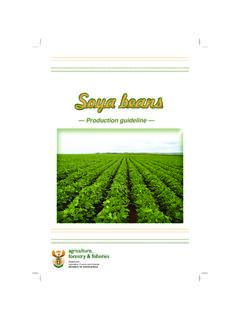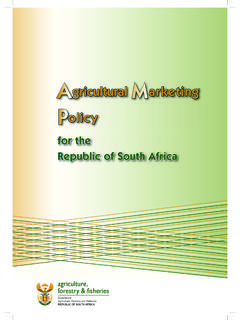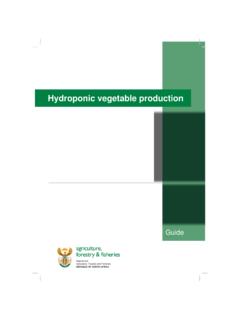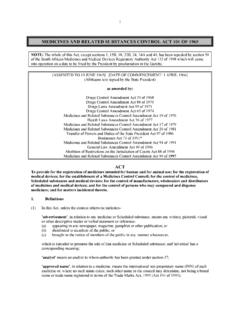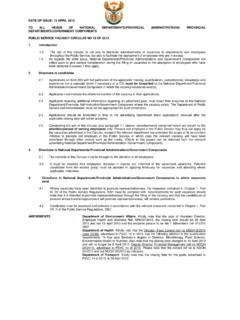Transcription of DEVELOPING AND MANAGING SMALL HERD OF BEEF CATTLE ...
1 DEVELOPING AND MANAGING SMALL HERD OF beef CATTLE Introductions beef production is a large and important segment of South African farming. beef farming works well with other agricultural enterprises like grain (in particular), orchard, vegetable, or other crop operations. CATTLE can make efficient use of feed resources that have little alternative use, such as crop residues, marginal cropland, and land not suitable for tillage, or land that cannot produce crops other than grass. For people who own land but work full-time off the farm, a beef enterprise can be the least labour-intensive way to utilize their land. A CATTLE enterprise can use family or surplus labour.
2 Calving, weaning, vaccinations, castration, and weighing can be planned for times when labour is available. Consider your resources, the land available, and your level of interest and capabilities before deciding to engage in the CATTLE business. Identify why you want to raise CATTLE and set goals to achieve the most constant economic return or personal satisfaction. Your goals must be clearly defined, firmly fixed, achievable, and have a realistic time frame. Otherwise, your operation will lack focus. Production options There are few types of SMALL -scale CATTLE enterprises. Growing and feeding systems--In these operations, calves or wearners are either raised or purchased and then are fed (fattened for slaughter).
3 Included in this category are operations specializing in producing CATTLE for home use. Breeding herds--A breeding herd consists of cows and bulls that are used to produce calves for sale as breeding or feeder animals. Combinations of growing, feeding, and breeding herds Success of your operation will entirely depend on adapting a strategy that fits your needs and capabilities. Growing and feeding operations In a weaners (yearlings) operation, weaner calves are acquires after weaning at 10 to 15 months of age. They can be fed out and marketed in less than a year from the time of purchase. Thus, the investment on each calf is returned within a comparatively short time.
4 This type of operation may not require much land, but adequate facilities are essential so that animals can be kept comfortable and under control. Some good enterprises are based pasture operations. Weaned calves are purchased in early spring, go on pasture (when the grass is at its best with regard to productivity), and are sold when the pasture season is over. On the other hand, calves cost less during winter; therefore, depending on the cost of winter feed, this may be the best time to purchase CATTLE for the next pasture season. Purchase price and selling price greatly influence profitability in this enterprise. MANAGING calves Keep calves in an area that allows you to observe them quite closely for two weeks.
5 This enables you to prevent the spread of disease. Calves should have access to plenty and fresh water and feed. Working the calves requires a lot of patience, as they are easily excited and stressed. Consult a veterinarian for a health program that lowers the risk of disease for newly received calves. Breeding herds Establishing a breeding herd is a long-term objective. It also requires more land than in a situation where weaner feeding program is implemented. Consider how your available resources match your long-term objectives. There must be adequate feed, water, and fences to accommodate a year-round operation. Decide whether to have registered pure-bred CATTLE or commercial CATTLE .
6 Income from a commercial beef herd comes mainly from the sale of calves and old or cull animals. Sale of breeding stock is the main source of income from registered CATTLE . Care and management of registered CATTLE is more intensive than for commercial CATTLE . DEVELOPING a registered herd If your objective is to raise registered CATTLE and supply breeding animals to other CATTLE producers, it may be necessary to make large capital investments in purebred stock. Development of a registered herd means that both the sire and dam must be purebred and registered with the same national breed association on the stud book. You must keep accurate records and register the desirable purebred calves to be retained for breeding stock.
7 If you raise bulls for the beef industry, you must develop a selection program based on characteristics of economic importance, such as fertility, mothering ability, ease of calving, growth rate, and carcass merit. Also, use great care in the selection of breeding females, as considerable time and expense are involved. Competition is keen with already-established herds. However, there are successful registered herds with only 20 to 40 CATTLE . DEVELOPING a commercial herd The criteria for selection, or selling points, of good commercial cows depend on size, quality, age, condition, stage of pregnancy , and market price. You should select breed and cow size to match your feed resources and topography.
8 Local extension officers can give you an idea of what breeds are best suited to your area. Crossbreeding (mating animals from two or more breeds) can be an advantage in a commercial cow herd. Capitalizing on the merits of several breeds, plus the extra vigor from crossbred calves, may give you a competitive edge in the market. Remember that advances in genetic merit probably will not be realized for several years. Purchasing CATTLE There are many sources of good CATTLE , both registered (stud breeds) and commercial. Usually it's best to purchase from a successful and reputable breeder. They usually sell only sound CATTLE as breeding animals and they are helpful in giving advice to less experienced producers.
9 If you are inexperienced, it might be best to buy good, young, bred cows that have calved at least once. This reduces problems associated with calving heifers. If you purchase open heifers, you should breed them to a bull that has the traits for easy calving. MANAGING a cow-calf herd The major concern of CATTLE producers is profit. For a cow-calf herd, profits are determined by the percent calf crop (the number of calves weaned per cows bred), the weaning weight of the calves, the costs of maintaining breeding animals, and, ultimately, the sale price of the calves. Because your entire program depends on the fitness of the breeding animals, it is essential to maintain good herd health by not allowing the CATTLE to become too fat or too thin.
10 Cows do not milk as well and may have problems calving or getting bred if they are overweight or underweight (refer to Body Score Conditioning in beef CATTLE ). Bulls that are not in good condition may perform poorly during the breeding season. Breeding season It is ideal to have a controlled breeding season, rather than allowing the bull to run with the cows continuously. A month to one and half or even two months breeding season is recommended. The resulting shortened calving season increases the possibility of having a uniform set of calves to sell at market time. CATTLE of similar breeding and size usually bring more money. Another advantage is that you can concentrate your work with cows during calving into a short span, instead of having it strung out for months.
